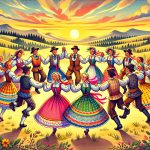
Chicago has a museum focused on Polish history, and it’s a great place to learn about how the Polish community has contributed to and lived through different times. This museum covers everything from the early days up to now, including important exhibits and artifacts. It also has educational programs that bring Polish heritage to life.
When we dive into the museum’s collections, we might find some stories and items that aren’t well-known but are really interesting. Getting to know these parts of the museum can give us a deeper appreciation for Polish history and make us think about the bigger picture of immigration and cultural identity in a new way.
The Museum’s Origins
The Chicago Museum of Polish History came to life thanks to the local Polish community’s desire to keep their rich culture alive in America. They wanted to make sure that the traditions and stories unique to Poland were not only preserved but also shared with a wider audience. This was more than just a project to remember the past; it was a way for the Polish diaspora to find their place and identity in their new country. As a result, the museum became a key place for sharing the Polish community’s collective memories and achievements, and at the same time, it played a significant role in promoting understanding and respect among different cultures.
The efforts to establish this museum highlight the importance of cultural preservation. For instance, through its exhibits, the museum showcases Poland’s major historical events and cultural practices, making it a living bridge between past and present for the Polish community in Chicago. It’s not just about looking at old artifacts; it’s about connecting with the stories and the people behind them. This approach has made the museum a vibrant center for intercultural dialogue, where visitors can learn about Poland’s contributions to world culture and history in an engaging and accessible way.
Besides historical artifacts, the museum organizes events and workshops that bring Polish culture to life for all visitors, Polish or not. These activities range from traditional dance performances to Polish language classes, offering a hands-on experience of Poland’s culture. It’s this dynamic and interactive approach that sets the museum apart and makes it a must-visit place for anyone interested in understanding the Polish experience in America.
Key Exhibits to Explore
Exploring the museum offers a deep dive into Poland’s fascinating culture and history. The exhibits are carefully selected to highlight Poland’s key historical events and cultural milestones. They showcase the country’s journey through times of division, resilience against oppression, and the quest for freedom, particularly emphasizing the solidarity movement. These displays not only recount Poland’s past but also shine a light on the enduring spirit of its people.
The museum has earned accolades from scholars and historians for its engaging storytelling approach. It uses a mix of artifacts, interactive installations, and multimedia to tell Poland’s story in a way that’s both informative and captivating. This method provides a well-rounded perspective on how Poland has been shaped by various socio-political events. It’s like taking a walk through time, where each exhibit adds a piece to the puzzle of Poland’s identity, sovereignty, and the relentless pursuit of liberty.
By focusing on key moments and figures in Poland’s history, the museum offers insights into the nation’s complex journey. For example, understanding the impact of the partitions of Poland sets the stage for appreciating the significance of the solidarity movement later on. This context helps visitors grasp the depth of Poland’s struggle and resilience.
The museum’s approachable and engaging way of presenting history invites everyone, from history buffs to casual visitors, to gain a deeper understanding of Poland. It’s not just a walk through the past; it’s an invitation to appreciate the forces that have molded Poland into what it is today and what it aspires to be in the future. Through this journey, the museum not only educates but also inspires, making history accessible and relevant to all.
Notable Polish Artifacts
This museum is home to several significant Polish artifacts that highlight Poland’s impressive history and cultural achievements. These items showcase the creativity, intellect, and resilience of the Polish people. They also highlight Poland’s important role in world culture and history. From medieval times to the Renaissance and into the modern era, these artifacts give us a glimpse into the economic, political, and cultural forces that have shaped Poland.
For example, imagine seeing an intricately carved medieval chest that once held royal treasures, or a Renaissance painting that captures the vibrant life of a Polish court. These aren’t just objects; they’re stories that bring Poland’s past to life. They show us how Poland adapted and thrived through different periods, contributing to arts, sciences, and politics on the global stage.
Exploring these artifacts further, we understand the complexity of Polish identity and heritage. It’s like piecing together a giant puzzle of Poland’s legacy, one that continues to influence the world today. This isn’t just about looking at old items; it’s about connecting with the stories and people behind them. It’s a journey that enriches our understanding of Poland and its place in the world.
In a way, walking through this museum is like walking through Poland’s history. Each artifact, from a simple tool to a majestic piece of art, tells a unique story. These stories are not just Polish; they are human stories that resonate with anyone interested in the rich tapestry of world history.
Educational Programs and Events
The museum, known for its extensive collection of Polish artifacts, goes beyond just displaying these items. It actively engages visitors with a variety of educational programs and events that bring Poland’s cultural and historical heritage to life. These activities help explain the stories behind the artifacts and place Poland’s contributions into a global context.
For instance, the museum organizes lectures, workshops, and interactive exhibitions. These are not just any events; they are led by scholars and experts in Polish culture, ensuring that the information shared is both accurate and insightful. Imagine attending a workshop where you learn traditional Polish crafts, or a lecture that dives into Poland’s role in significant historical events. These experiences are designed to be both educational and engaging, making learning about Polish heritage an interactive and memorable experience.
These programs are crucial in fostering an understanding and appreciation of different cultures. They’re especially valuable for the Polish diaspora, helping them connect with their roots, but they’re just as important for anyone interested in learning about Poland’s impact on the world. The museum, through these initiatives, becomes more than just a place to look at old objects. It turns into a vibrant learning center where history and culture are brought to life.
Visiting Information and Tips
If you’re planning a trip to the Polish history museum in Chicago, there are a few things you’ll want to keep in mind to make your visit as enjoyable as possible.
First off, it’s important to check the museum’s opening hours before you go. These can change, especially during different seasons or for special events, so it’s a good idea to either look at their official website or give them a call to get the most current information.
Next, take a look at the ticket prices. There might be discounts available that you can take advantage of, like reduced rates for students, seniors, or museum members. This can help you save a bit of money, which is always a plus.
Considering the museum is in a busy part of Chicago, parking can be tricky to find. So, you might want to think about using public transportation or finding a parking spot ahead of time through a parking app, which can save you from a lot of stress and circling around looking for a space.
Before you head out, it’s also a good idea to check what exhibitions and programs the museum has going on. This way, you can make sure you’re visiting when there’s something that really interests you. Their website should have all the info you need, or you could call ahead and ask. This little bit of planning can really help you get the most out of your visit.
Conclusion
Exploring Polish history at the Chicago museum gives us a deep look into the lives and stories of the Polish community. From its beginnings, through to its special displays, important items, and wide-ranging educational activities, the museum is a key place for keeping Polish traditions alive.
When you visit, you learn a lot about Polish culture and understand how it fits into the bigger picture of history. This makes the museum an essential spot for researchers, teachers, and anyone interested in learning more.






Comments are closed.